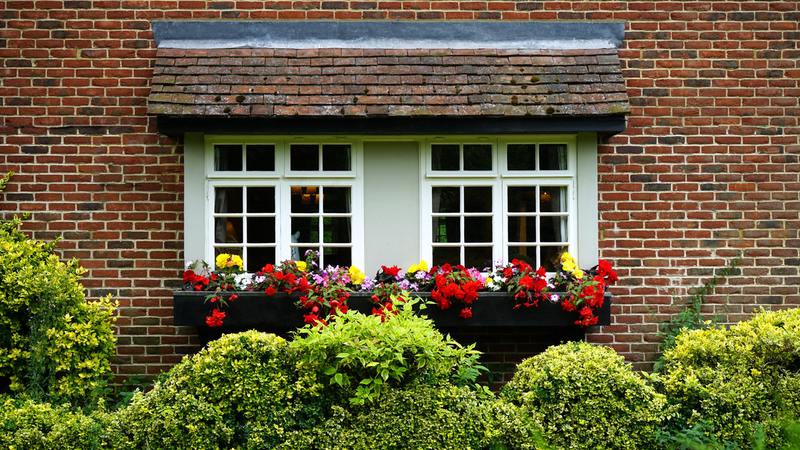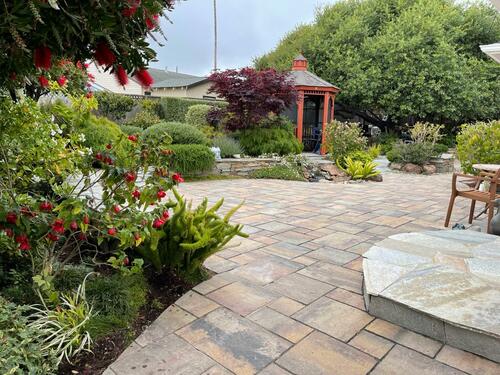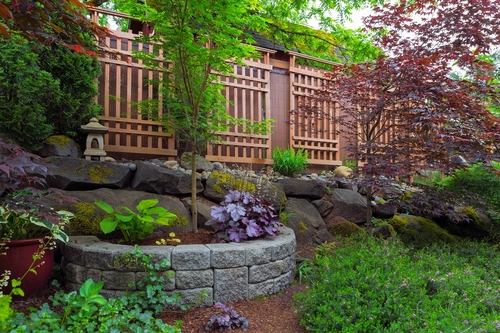Hardscape vs. Softscape: Understanding the Essentials of Landscaping
What is Hardscape?

An Elaborately Hardscaped Tiered Patio – Image by Michelle Raponi on Pixabay
Hardscaping is a design that is constructed using both man-made and natural nonliving materials. This includes landscaping details like concrete and stone walkways, retaining walls, patios, decks, potting containers, stepping stones, and other designs that use wood, sand, stone, brick, pebbles , metal, and other hard materials.
Good examples of hardscaping include:
Almost every well-planned landscaping project incorporates some hardscaping. Even aspects as small as a stone retaining wall or wooden garden boxes are considered hardscaping, as long as man-made and/or non-living materials are used.
Importance of Drainage in Hardscaping
Drainage is crucial in hardscape design. Depending on what you are building or having built, you may need to include artificial drainage to keep your soil high quality and ensure that your plants get enough water. Properly executed hardscaping benefits your garden, the design of your landscape, and the local ecosystem. Many horticulturalists opt for more hardscape to save water while maintaining a beautiful property.
Indoor Hardscaping
Hardscaping is also popular in indoor gardens. You can use planters, pots, and other man-made details to turn your indoor plants into a gorgeous display that enhances your decor. Examples of indoor hardscaping include:
- Pebbles
- Sand
- Shelves
- Racks
- Fountains
- Planters
- Pots
What is Softscape?

Softscaping Elements Bring Color to a Brick Wall – Image by VariousPhotography on Pixabay
Softscaping is essentially the opposite of hardscaping. This trend in landscaping comprises the living horticultural elements of landscaping design, focusing solely on plants.
Examples of softscape include:
- Lawn grass
- Flowers
- Trees
- Shrubs
- Vines
- Ground covers
Blending Hardscape and Softscape
Softscape softens the hard edges created by hardscaping. For example, a patio with hard lines can be softened by flowers or other plants around it, creating a better flow and bringing the entire look together.
Pros: The Benefits of Hardscaping

Stone Stairs Accented with Flowers – Image by Mali Maeder
Hardscaping offers numerous advantages that can enhance the functionality and aesthetics of your outdoor space.
Water Saving
One of the primary benefits of hardscaping is its ability to conserve water . Unlike softscape elements, hardscaping does not require regular watering, making it an excellent choice for areas prone to drought or water restrictions.
Durability and Longevity
Hardscaping materials, such as stone, concrete, and metal, are incredibly durable and can withstand various weather conditions. This longevity means that once installed, hardscape features can last for many years with minimal maintenance.
Functionality
Hardscaping elements can provide essential functionality to your outdoor space. Patios, walkways, and retaining walls can enhance the usability of your garden, making it easier to navigate and enjoy. Features like pergolas and gazebos offer shaded areas for relaxation and entertaining.
Weather Resistance
Hardscaping is perfect for any weather condition. Whether it’s hot and dry or cold and wet, hardscape materials maintain their integrity and appearance, ensuring your landscape looks great year-round.
Pros: The Benefits of Softscaping
Softscaping brings natural beauty and environmental benefits to your landscape design.
Affordability
Softscaping is generally more affordable than hardscaping. The cost of seeds, plants, mulch, and soil is typically lower than that of man-made materials. This makes it an accessible option for those on a budget.
Natural Beauty
The living elements of softscaping add color, texture, and life to your garden. Flowers, trees, and shrubs create a vibrant and dynamic landscape that changes with the seasons.
Biodiversity
Incorporating a variety of plants into your landscape promotes biodiversity, which is beneficial for the local ecosystem. Diverse plant life supports wildlife, including pollinators like bees and butterflies.
Flexibility
Softscape elements are easier to change and update compared to hardscaping. You can experiment with different plants, colors, and arrangements to suit your preferences and adapt to changing trends.
Cons: The Drawbacks of Hardscaping

A Hardscaped Backyard Patio Lined with Greenery
While hardscaping has many benefits, there are also some potential drawbacks to consider.
Cost
Hardscaping can be expensive. Materials like stone, wood, and metal can be costly, and hiring professionals to install hardscape features can add to the expense. It’s important to budget carefully and consider the long-term investment.
Maintenance
Although hardscaping is generally low-maintenance, certain features may require upkeep to remain in pristine condition. For example, wood elements may need sealing or staining, and stone surfaces may need occasional cleaning.
Environmental Impact
The production and transportation of hardscape materials can have a significant environmental impact. It’s essential to choose sustainable materials and practices to minimize this effect.
Cons: The Drawbacks of Softscaping
Softscaping, while beautiful and beneficial, also has its challenges.
Lifespan
Softscape elements, such as plants, have a shorter lifespan compared to hardscaping materials. Plants can die or become damaged, requiring replacement and ongoing care.
Maintenance
Softscaping requires regular maintenance, including watering, pruning, fertilizing , and pest control. This can be time-consuming and may require a commitment to keep your garden looking its best.
Seasonal Changes
The appearance of softscape elements can vary with the seasons. While this provides a dynamic and ever-changing landscape, it also means that your garden may not always look its best year-round.
Our Final Thoughts

A Fenced Yard with Hardscape and Softscape Elements
So, which is better—hardscape or softscape? We believe both are equally wonderful, each offering unique benefits and potential drawbacks. To create a balanced and beautiful landscape, we recommend incorporating both hardscaping and softscaping elements in your yard. They complement each other beautifully and together will create a stunning landscape for years to come.
By integrating the durable, functional aspects of hardscaping with the natural beauty and flexibility of softscaping, you can achieve a landscape that is both visually appealing and practical. Whether you are designing a new garden or updating an existing one, a thoughtful combination of hardscape and softscape elements will enhance your outdoor space and provide enjoyment for years to come.
Additional Resources
For more information on landscaping, check out our other blog posts on patio design ideas and the best plants for your garden. Whether you are looking for inspiration or practical advice, we have the resources to help you create your dream landscape.
Originally posted on July 27, 2018.
We may receive affiliate compensation for some of the links below at no cost to you if you decide to make a purchase.


